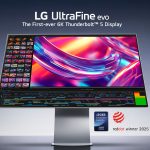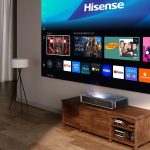Introduction: A New Era for Ultra-HD Projectors
In a bold push to merge cinematic quality with smart-TV convenience, BenQ has introduced two flagship home theater projectors: the TK705i and TK705STi. These units aren’t just incremental upgrades—they mark a turning point in projector design by combining high brightness, gamer-friendly features, and Google TV built in.
Below, we deliver a full breakdown of their specifications, features, positioning, and real-world implications—plus an anticipatory comparison with competing models.
Core Specifications & Optical Design
| Feature | TK705i | TK705STi |
|---|---|---|
| Native 4K (via pixel shift) | ✔️ | ✔️ |
| Brightness | 3,000 ANSI lumens | 3,000 ANSI lumens |
| Throw Ratio / Lens | 1.0–1.3:1, 1.3× motorized zoom | 0.8:1 fixed short-throw lens |
| Contrast Ratio | 600,000:1 FOFO | 600,000:1 FOFO |
| Color Space | 98% Rec. 709 coverage | Same (98% Rec.709) |
| Gaming & latency | HDMI 2.1, 5 ms @ 4K/60Hz, ALLM, HDR-RPG / HDR-FPS | Identical low latency setup |
| Smart platform | Google TV (based on Android 15) | Google TV built in |
| Audio | 2 × 8 W built-in speakers | Same 2 × 8 W units |
| USB-C Power Output | 30 W | 30 W |
| Projection Size | Up to 150″ diagonal | Up to 150″ |
These projectors feature LED light sources with an estimated 20,000-hour lifespan. Advanced image correction tools—such as keystone, image fit, auto focus, and auto alignment—simplify setup.
Smart Features: Google TV at the Core
By embedding Google TV (Android 15), BenQ bypasses the need for external streaming devices. Users gain:
- An intuitive, content-first interface with personalized recommendations
- Full access to over 15,000 streaming apps (Netflix, Prime Video, YouTube, Disney+, etc.)
- Chromecast / Google Cast built in for screen mirroring
- Voice control via Google Assistant across the OS and apps
- Multi-user profiles and tailored watchlists
- Parental controls and safe viewing modes via Family Link
BenQ’s support documentation warns that Google TV updates (security patches or OS upgrades) may depend on region or device support.
Gaming & Console Support
BenQ places gaming support front and center:
- 5 ms input lag at 4K/60Hz is a standout claim—rare among projectors in this class.
- With HDMI 2.1 + Auto Low Latency Mode (ALLM), it adapts automatically to console sources.
- Dual HDMI 2.1 ports enable flexible multi-device use (console + streaming box, etc.)
- The USB-C port’s 30 W output provides power to handhelds or small devices while gaming.
- HDR game modes (HDR-RPG, HDR-FPS) optimize color and contrast for varied game types.
From casual gaming to console competition, these projectors are built to respond.
Placement & Room Suitability
TK705i
The zoom lens (1.0–1.3×) grants placement flexibility. In mid-size to large rooms with moderate throw distances, users can adjust image size via lens, reducing need for physical repositioning. Auto keystone and centering help fine-tune alignment.
TK705STi
The short-throw 0.8:1 optics enable a massive image from a short distance—ideal in small living rooms, bedrooms, or compact media areas. This design requires more careful placement but makes large screens possible in limited space.
Both can be ceiling mounted or inverted for flexibility.
Pricing & Market Positioning
In European markets:
- TK705i: ~ €1,399 (or £1,249 in the UK)
- TK705STi: ~ €1,599 (or £1,399 UK)
These prices position them in the premium home entertainment/gaming projector segment—competing with high-end smart projectors and large premium TVs.
Strengths, Limitations & Use Cases
Strengths
- All-in-one smart projector: With Google TV built-in, no external box is needed.
- Excellent brightness with LED: 3,000 ANSI lumens makes them usable even in rooms with ambient light.
- Low latency and gaming readiness: BenQ’s 5 ms spec + HDMI 2.1 is a rare combo.
- Image flexibility: Motorized zoom (TK705i) and short throw (TK705STi) cover different setups.
- Modern connectivity: USB-C power delivery, dual HDMI 2.1, wireless casting.
Limitations & Considerations
- LED sources may not match peak brightness or contrast of high-end laser projectors.
- Google TV updates may vary by region—platform support longevity is a factor.
- Built-in speakers (2×8 W) are modest—most users will want an external sound system.
- In very bright rooms, 3,000 lumens may still fall short compared to premium laser TVs or ultra-bright projectors.
- Fixed optics (especially in the short throw model) reduce flexibility in extreme setups.
Best Use Cases
- Home theaters in dark to moderately lit rooms
- Game rooms or multi-use living spaces
- Small apartments where large screen size is needed over distance
- Users who prefer a single, smart integrated device over a projector + streaming box combo
Competitive Landscape & How BenQ Stacks Up
Compared to alternatives, BenQ’s approach is significant:
- Many projectors still rely on external streaming devices; BenQ’s built-in Google TV simplifies setup.
- Laser projectors typically lead in brightness; these LED models aim to bridge that gap with smart features.
- Some rivals (e.g. Epson, Hisense) are pushing ultra-short-throw or triple-laser systems—but often with higher costs or fewer gaming features.
- BenQ’s pricing undercuts many premium smart laser projectors while offering competitive image/gaming specs.
In sum, BenQ delivers a compelling mix of smart, versatile, and performance-focused design.


